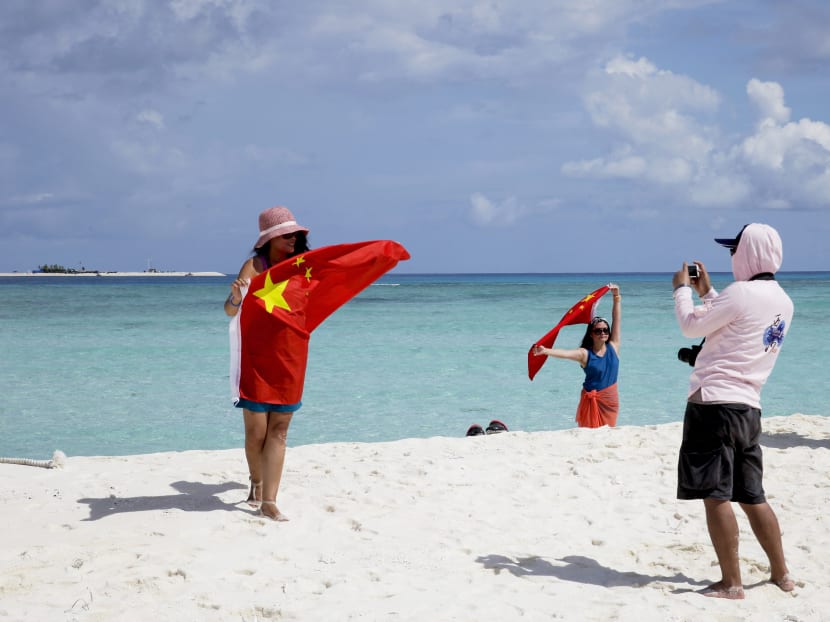Disputed isles a tour destination for patriotic Chinese
ABOARD THE COCONUT PRINCESS — Mr Zhang Jing watched the grey shells of the Paracel Islands emerge from the purple, predawn South China Sea. Here was the focal point of a cruise more about politics than pleasure.

Chinese tourists taking photos with their national flag at Quanfu island, part of the disputed Paracels. Photo: AP
ABOARD THE COCONUT PRINCESS — Mr Zhang Jing watched the grey shells of the Paracel Islands emerge from the purple, predawn South China Sea. Here was the focal point of a cruise more about politics than pleasure.
Cheers erupted on board the Coconut Princess at the sight of the distant land, and Mr Zhang and the other passengers scurried to take pictures of each other at the railing holding the country’s bright red flag. A few kilometres away, a Chinese navy frigate cruised by silently, part of the country’s continuing watch over the tiny islands it has long claimed as part of its territory.
“This is the southern frontier of China,” said Mr Zhang, a policeman, when he had reached one of the islands. “As a Chinese, I feel proud to come here and declare sovereignty.”
With him and 167 other Chinese tourists on board, the ship had travelled more than 320km south of Hainan Island off China’s southern coast to what they said was an indisputable outpost of their country.
Each had waited months for permission to join the five-day tour and spent from US$1,200 (S$1,500) to about US$2,000 to visit these barren patches of sand, making do with the bland cabbage and noodles on board as well as blackouts of mobile phone service.
They came to celebrate China’s growing power in the region and help press its claim to the 130 coral islands and reefs of the Paracels, known to the Chinese as the Xishas.
Beijing is locked in disputes with Vietnam, the Philippines and other neighbours over much of the strategically crucial South China Sea, which holds important shipping lanes, rich fishing waters and — possibly — billions of barrels of oil. Patriotic tourists have become the region’s latest territorial chess pieces.
The tour company that Mr Zhang used visits the southern Paracels. Since starting the tours in May last year, it has ferried about 3,000 people to the islands, which are no bigger than a few square kilometres.
The cruises are useful to China because under international law, it must prove a civilian and not only a military use for the islands to claim sovereignty, said Dr Kang Lin, a researcher at the National Institute for South China Sea Studies.
“Tourism to Xisha is a very good civilian tool to declare our sovereignty over the islands, and it is supported by international laws,” Dr Kang said. “China will speed up its exploration in the Xisha Islands.”
The dispute has at times become heated and there are concerns it could escalate. Over the summer, Vietnamese and Chinese boats repeatedly rammed each other in the Spratly Islands, south of the Paracels, after the Chinese moved an oil rig into contested waters.
Dr Bernard Loo, a military studies professor at the S Rajaratnam School of International Studies in Singapore, said stoking nationalist fervour could backfire on leaders in Beijing if they eventually opt for a more conciliatory approach with China’s neighbours.
“Playing the popular card is always potentially dangerous because you may unleash forces you can’t control,” said Dr Loo. “But if (China) really wants to reinforce its claims to the Paracels and, if necessary, resort to military force, it helps to get the population on its side.” AP





